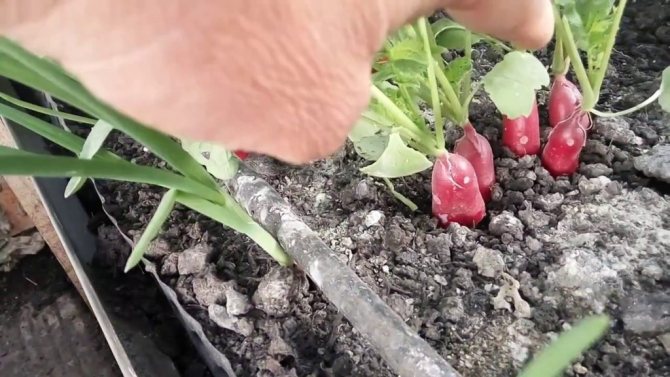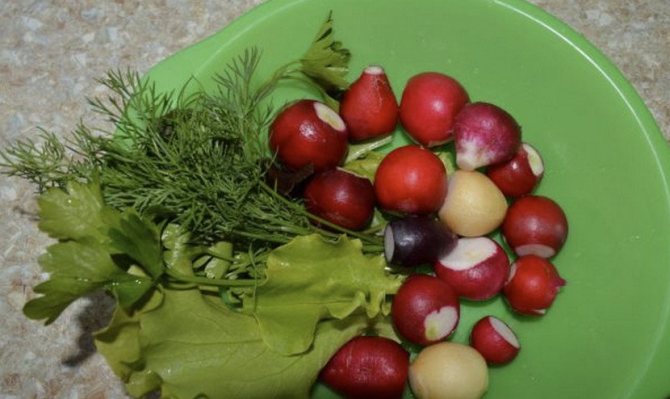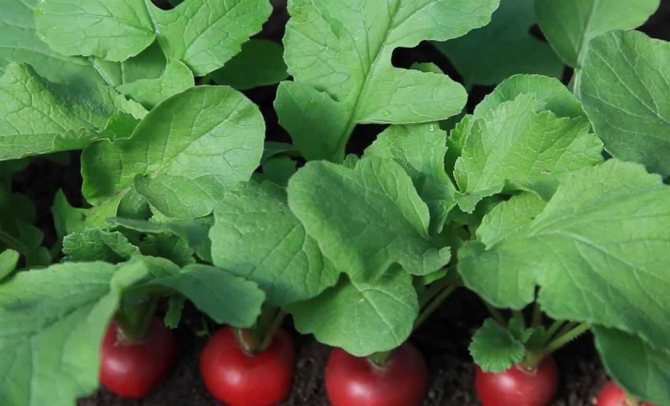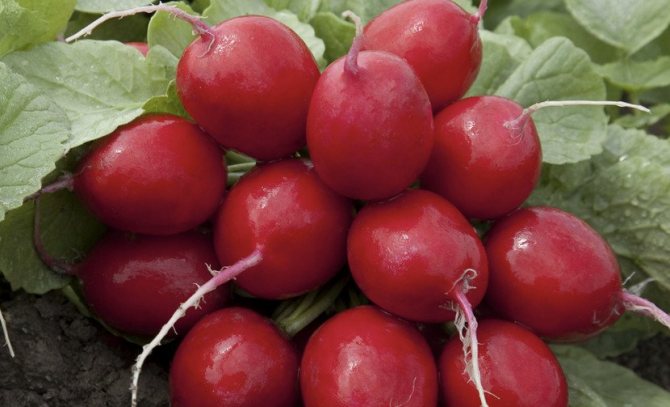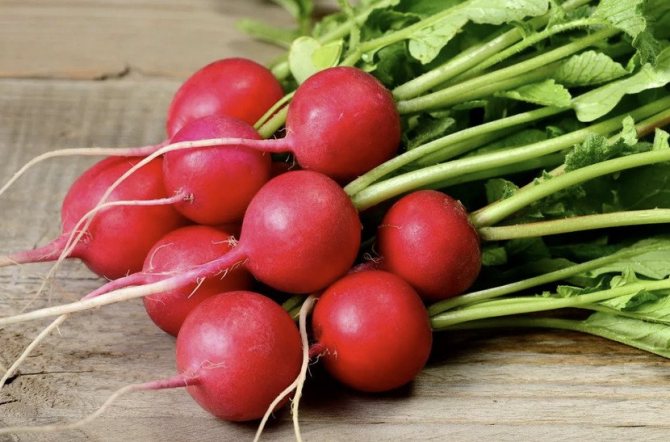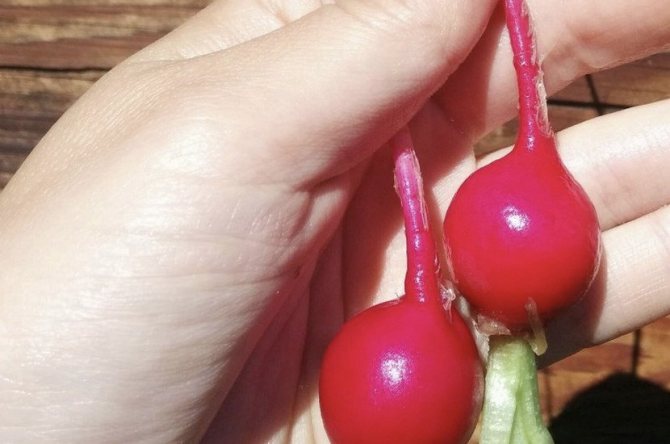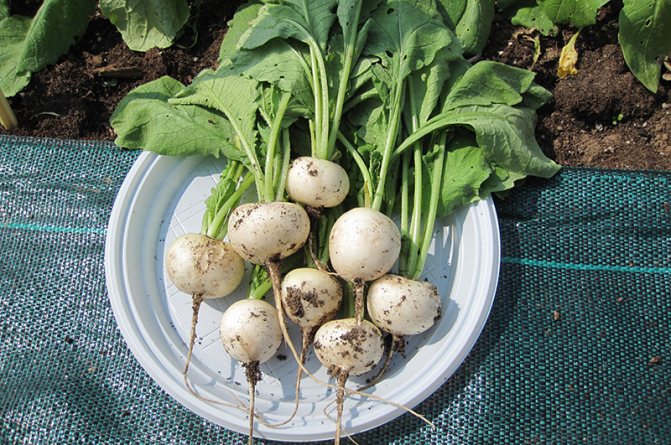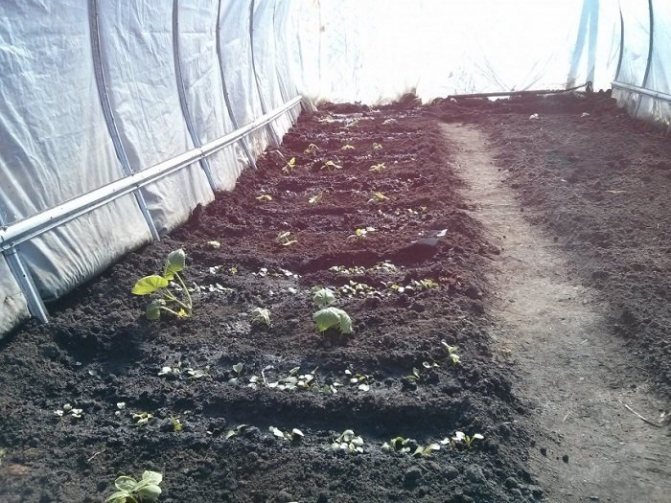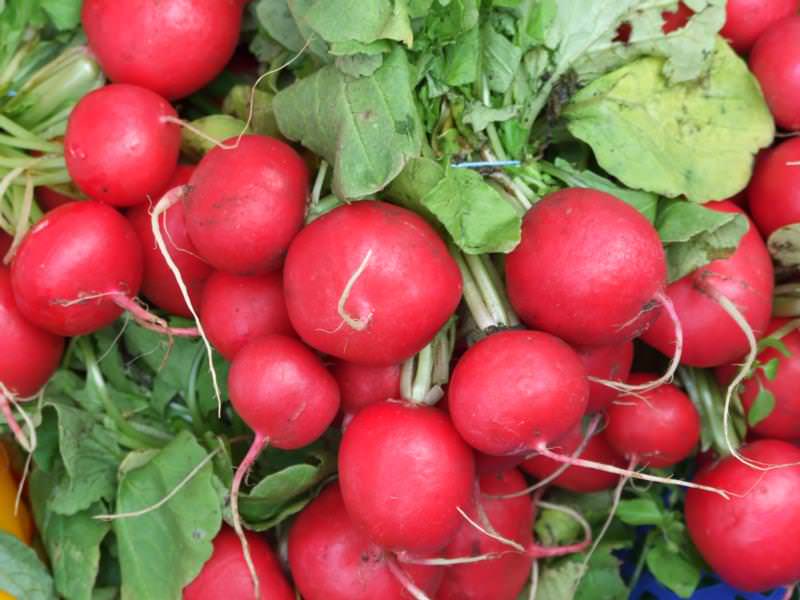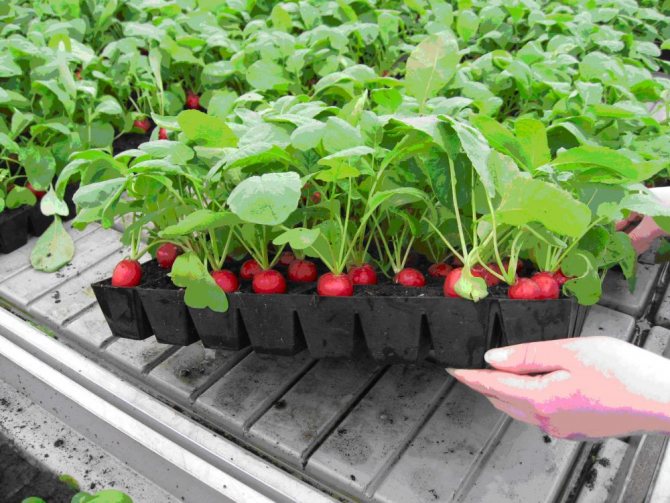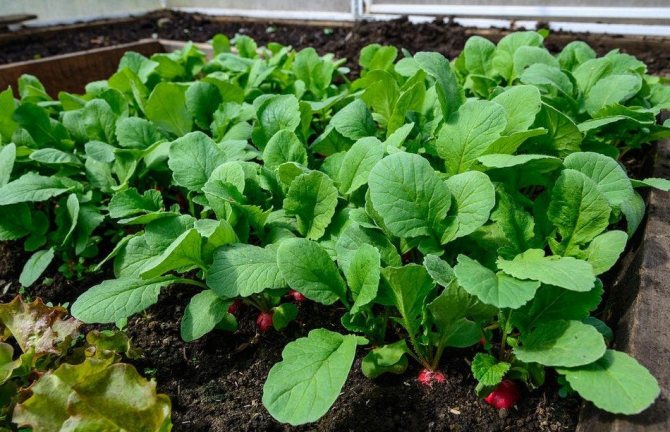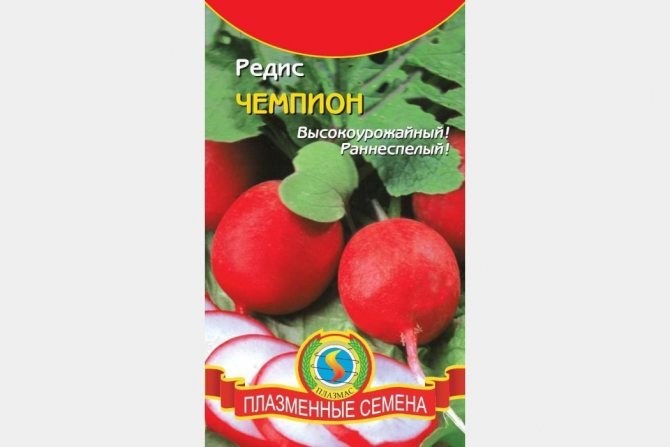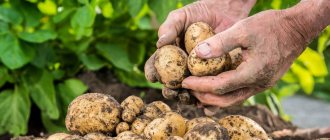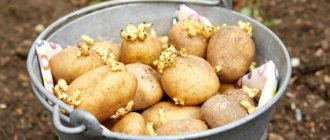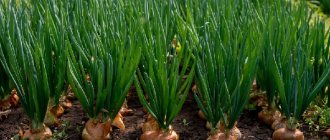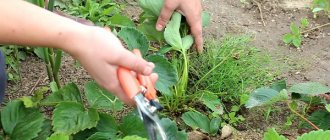The seasonal cultivation of radishes in a greenhouse in winter is a task that beginners can do. The first rule is the choice of a cold-resistant variety. The top list includes "Gribovsky", "early red", "ruby", "dawn" and so on. From the moment of planting to harvest, 25-30 days will pass. The second rule is that in indoor conditions, the vegetable needs artificial lighting. In the case when the design of the greenhouse does not allow the installation of additional light sources, it is worth growing early, winter-hardy varieties. We are talking about "Tarzan", "Debel", "Coral" and "Donar".
How to plant radishes in a polycarbonate greenhouse in spring
One way to plant radishes is to plant them in a polycarbonate greenhouse. Why exactly in this, and not in glass or with polyethylene. It's simple, these are the most common today, but all recommendations apply to other types of greenhouses and closed rooms. So let's get started:
When the temperature outside begins to warm, and in the greenhouse the ground warms up with a bayonet, start planting. And do not be afraid that everything will freeze, this vegetable is an unpretentious and cold-resistant culture that can withstand frosts down to -4 degrees, and sprouts appear during germination already at + 2 ... + 3.

Check with


so that they are optimal and you do not have disappointment with the work done. Find the right variety for planting. I want to note that not every variety will grow normally indoors, some of them are designed only for open ground. This is mainly due to less light and stagnant air in the greenhouse. The best for indoor spaces are considered: from early ripening, for example, "Alex", "18 days", "Globus F1" and "Ultra early"


a little later "Warta", "Helro", "Silesia", "Saksa" will ripen


even later, "Rova", "Heat" will give a harvest.


But, of course, these are only recommendations, you can plant any variety you like, the main thing is to pay attention to the planting conditions, and do not plant varieties for open ground.
Let's start landing:
1. Select a bed and dig it up, loosen and level.
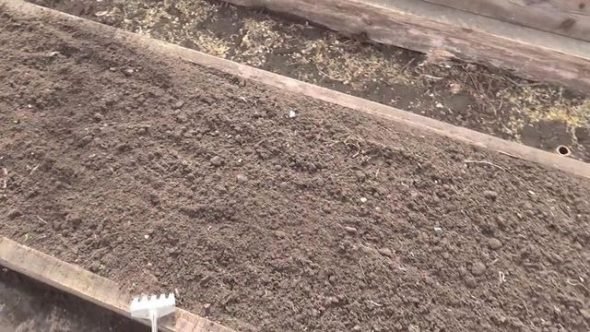

2. Spill over with phytosporin solution. With any stick, at a distance of about 5 cm from each other, make small indentations. The depth of the pits should be 2-3cm.
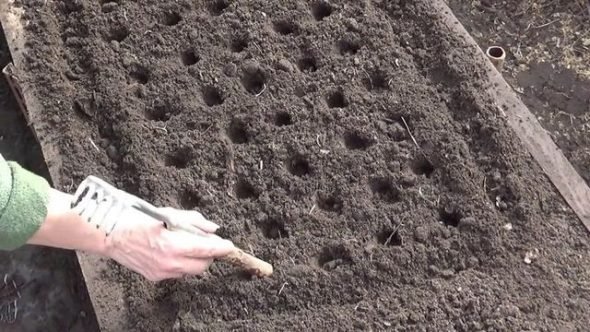

3. Dip one seed into each hole
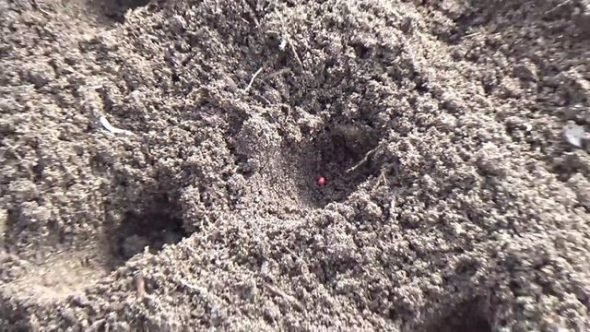

and level the bed with your hands, filling in all the grooves.
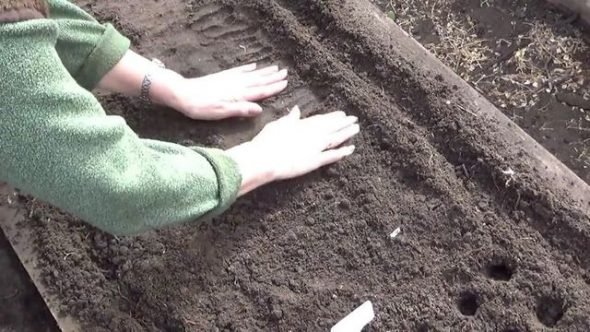

4. Cover the bed with plastic wrap. That's it, the landing is over!
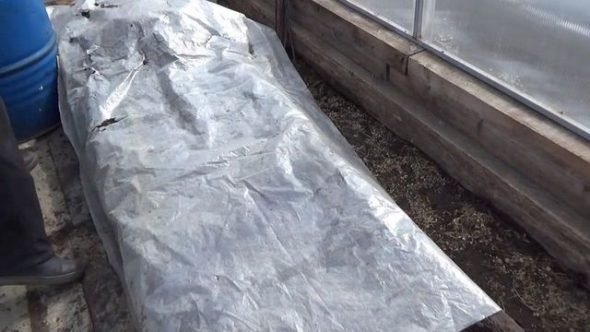

Do not remove the film until shoots appear, and also do not water. When the first shoots appear, open the garden bed.
Cultivation conditions
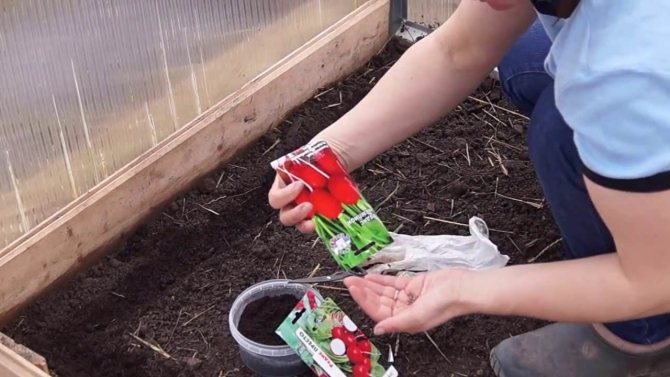

Radish seeds germinate quickly, the root crop is formed in a month. In one season, you can collect 3-4 crops of vegetables. The temperature for seed germination should be at least + 11 * C, optimal + 18 * C. Higher temperatures will provoke the growth of arrows, so vegetables are grown mainly in spring or autumn.
If the duration of daylight hours is 13-14 hours, and in the greenhouse it will be higher than + 24 * C, then the radish will quickly begin to bloom. With a cold snap and a lack of light, the development of plants is suspended, the fruits will ripen only after 8 weeks.In a polycarbonate greenhouse, you can plant vegetables early, the material keeps heat well and the seedlings do not freeze even in February.
Sandy loam, light soils are suitable for root crops. Acidic soil is not suitable for growing radishes. Radish needs moisture for development, the soil must not be allowed to completely dry out, in this case the seedlings will die.
Attention! Radish does not like weeds; with an overgrown area, the fruits are small and bitter.
Planting radishes in a polycarbonate greenhouse according to the lunar calendar
As you can see, planting radishes is a very simple operation that does not require special knowledge. But as in any business, there are nuances and subtleties. One such feature that allows you to grow a larger crop is planting according to the lunar calendar. You can treat it in different ways, but those who sit on auspicious days celebrate the best results. Try it yourself.
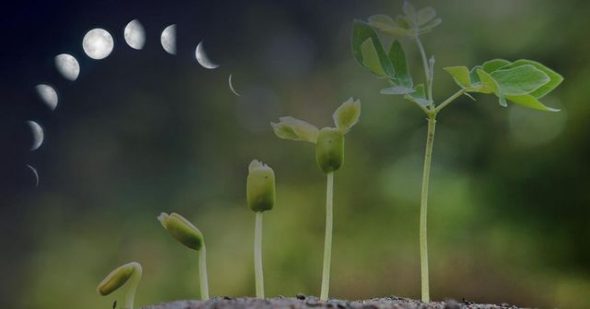

Let's turn to the calendar and define:
- February: 1, 5, 6, 7, 12, 13, 15, 18, 19, 20, 24, 25
- March: 3, 4, 5, 6, 17, 18, 22, 27, 28, 29, 30
- April: 1, 2, 10, 12, 13, 14, 18, 19, 28, 29
- May: 5, 6, 11,12, 25, 26
- June: 2, 3, 4, 6, 8, 12, 13, 17, 18, 22, 23, 30
If you pay attention, you will see that favorable days fall on the waning moon. This is the basic rule of the gardener's lunar calendar. Everything that grows under the ground is planted on the waning moon, and everything that grows above the ground is planted on the waxing moon. Remember this, look at the calendar and choose the most favorable days for you.
What is a podzimny sowing of radishes?
The definition of what is podzimnie crops is laid down in the very name of the method - crops before winter. It is the sowing of seeds in the beds at a stable air temperature in the region of 0 ° C and a soil temperature of +2 ... + 4 ° C is called winter sowing. In different climatic zones, this moment occurs at different times, there is somewhere around the end of October, and in other places in November.
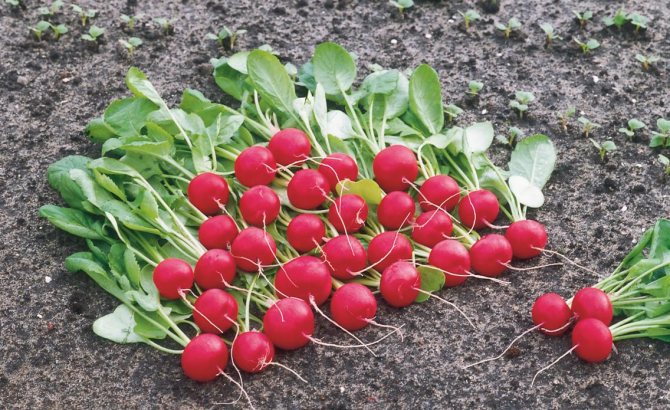

When and at what temperature can radishes be planted in a greenhouse
It will not be an exaggeration if I say that this vegetable can be planted from March to October. But, as in any business, there are exceptions. The fact is that radish is a short-day root crop. In order for it to grow well, it needs no more than 10-11 hours of daylight. He also loves cool and sunny weather.
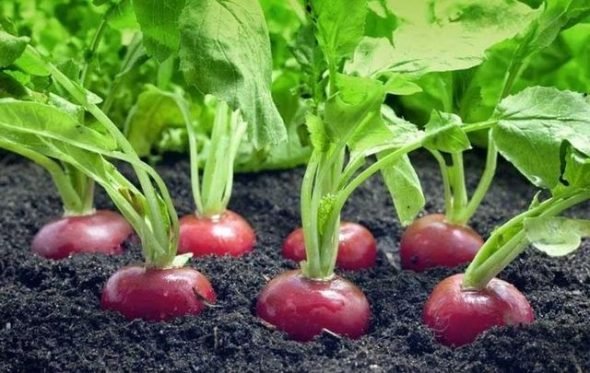

That is why months such as June and July are completely unsuitable for him. Of course, it is possible to plant, but it is unlikely to harvest. It will all go into arrow and color. You can try darkening with opaque materials, but I have never tried this, so I do not give advice. Try to avoid these two months from planting. The best months, I repeat, are March, April and May. This is the time when there are no other vegetables yet, and radishes are a welcome firstborn on our table.


Disease prevention
The most common radish disease is black leg. The vegetable gets sick due to waterlogging of the greenhouse atmosphere.
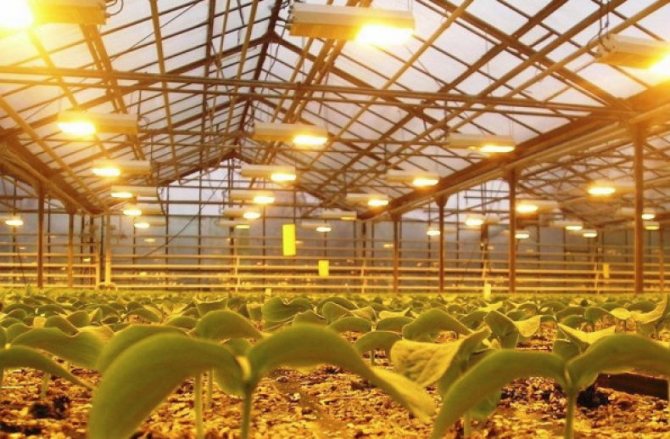

Experts recommend, for prevention, to treat plants with a mixture of a solution of wood ash (200 g) and laundry soap (50 g) per bucket of water. The same remedy will scare away pests (caterpillars, cabbage moth, midges) from seedlings. You can fight them by pollinating radishes with a mixture of sifted wood ash with tobacco dust.
Autumn planting of radish in the greenhouse
When you calmly finished all your gardening and gardening chores, wrapped the trees and bushes from rodents, prepared everything for wintering, and the ground began to freeze, it’s time for the autumn planting of radishes.
Since the next year's seedlings will appear in early spring, when the daylight hours are very short, it is better to choose early-maturing or mid-early varieties that are resistant to low light, such as "Heat", "Zarya", "Pink-red with a white tip".


Harvest with this method of planting 2-3 weeks earlier than with spring plantings, plus the seeds, being hardened, undergo natural selection, and only the strongest survive, and as a result, vegetables grow healthy and strong.Also, plantings of radish planted before winter are very resistant to disease, frost and pests, and its sprouts do not suffer from pests. But there are also downsides to this method. There is a risk that with a prolonged thaw, the ground in the greenhouse will thaw and the plant will begin to grow, and subsequent frosts will kill everything. Therefore, before planting before winter, think about whether it is worth the risk or not. The planting process itself is no different from the spring one.
1. Wait for night temperatures below freezing so that the top layer of soil around the greenhouse is constrained.
2. Dig up the bed. Level the ground. Apply fertilizer.
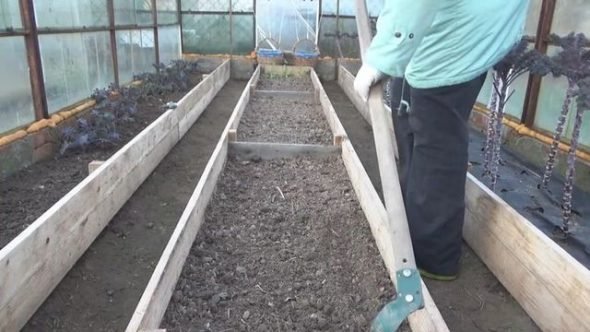

Recommended fertilizer rates:
- 1/2 bucket of compost
- 15gr. potassium salt
- 50gr. superphosphate
3. Make holes 2-3 cm deep in any way convenient for you at a distance of 5 cm from each other.
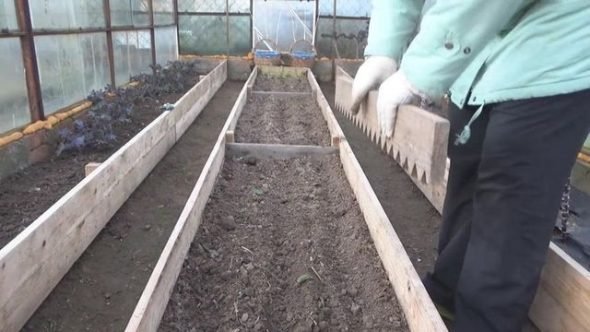

4. Place 2 root vegetable seeds in each hole.
This is done in case not all seeds overwinter safely.
5. Cover all grooves with earth. Do not water! The ground must be dry!


6. When the snow falls, fill all the beds with it, so the seeds will be warmer, and in the spring it will give the necessary moisture.
At this point, the landing can be considered complete.
Harvesting and storage methods
It is not worth delaying the harvest. After the ripening period specified by the manufacturer, you must first pull out one root crop and see if it has reached maturity. If the fruit is not yet ripe enough, you should wait another 3-4 days. Radish usually ripens amicably, so it is harvested all at once.


Before harvesting in the morning, radishes are watered abundantly, and at lunch they are torn by hand. For further storage, it is necessary to carry out the correct processing of the fruit. First, they need to be freed from the tops. It is better to cut a cut 1 cm above the root crop itself. After that, the tops are left on the mulch, and the fruits are immersed in water for 2 hours and washed from dirt. After that, the radish is dried and packaged in bags. In this form, in the refrigerator, the fruits retain their useful qualities for a month.
Important! Storage figures for radishes are approximate and depend to a large extent on the variety.
How to plant radishes in a polycarbonate greenhouse on the snow
I am often asked if it is possible to plant radishes in the snow and how to do it. I will say right away - you can, the root crop we plant is cold-resistant and tolerates shallow frosts. We will not ask the question of why this should be done, we will try to answer how to do it.
The technology is as follows:
In the greenhouse, prepare a bed, apply a layer of snow 2-3 cm thick on it.
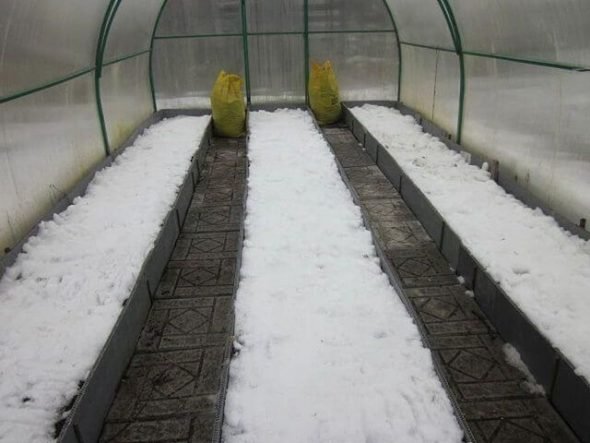

On the snow, with a step of 5 cm from each other, place one radish seed at a time and cover it with glass on top.
Snow is needed to moisten the earth and harden the seeds. The melted snow will moisten the soil, and the glass on top will prevent moisture from evaporating.
When sprouts appear, remove the glass. I also recommend adding potassium-phosphorus fertilizers to the garden bed before applying snow at the rate of 15 g per 1 m².
That's all. Give it a try and write reviews.
The best medium to late ripening varieties
Mid- and late-ripening radishes take longer to ripen than early ones. However, such a nuance has a positive effect on the condition of the root crop. During ripening, the taste becomes soft, balanced, so many summer residents choose such varieties to the detriment of early ripening. The best varieties are below.
Table 2. The best medium and late-ripening radish varieties
| "Heat" | 22-40 days (depending on the conditions in the greenhouse) | The easiest variety for lovers of the classics. Dislikes heat and dry land. The fruits grow round, no heavier than 15 grams. The pulp is delicate in taste, without bitterness. The variety gives a yield of up to 3 kg. per square meter of the garden. |
| "Würzburg 59" | 26-35 days | The variety is not subject to flowering. Root crops are not flabby, they steadfastly perceive arid soils. Radish is stored for a long time, it has a dark color and sweetish pulp. You can get 1.7 kg of radish per square meter. |
| "Rova" | 29 - 32 days | Fruits are small, weight does not exceed 9 grams.They have a regular round shape and red color. Small veins are present. |
Planting radishes in egg cells in a greenhouse
As I said, there are a lot of ways to grow radishes. I want to share with you one very interesting, in my opinion, landing option. This is a planting in chicken egg cassettes. They are made from molded paper pulp, and are safe for soil and vegetables. When growing radishes in cassette cells from under eggs, nothing will interfere with its growth and cannot harm it during thinning, since each of the seeds grows separately. Also, cassettes act as mulch, preventing weeds from growing.
1. Let's get started. Prepare the required number of cassettes.
2. For each cassette with a clerical knife, on one side, cut off the tops of the cells.
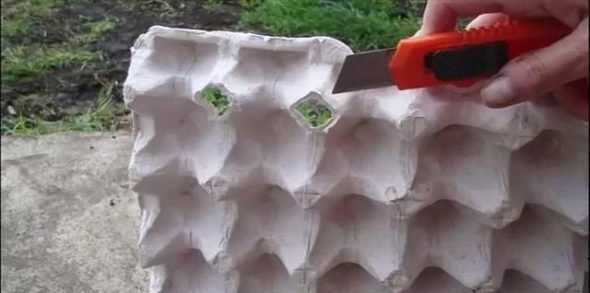

place the cassettes on the bed with the cells down.
3. Press them lightly into the ground so that there is no air gap between the cassette and the ground. So that the earth protrudes from the holes.
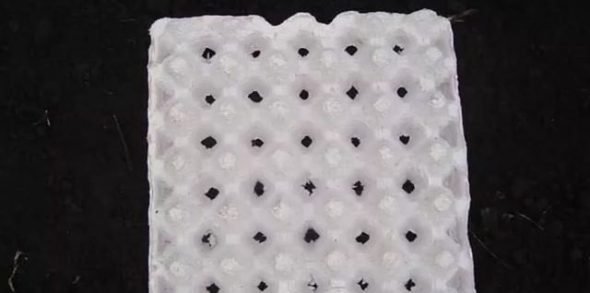

4. In each cell, directly on the ground in the holes, put one seed.


5. Sprinkle the cassettes with a layer of clean sand. Drizzle liberally with water.
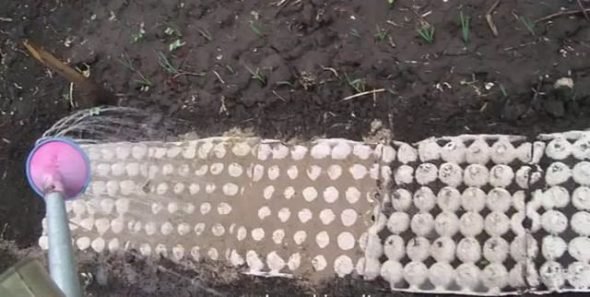

6. Cover with foil or agrofiber.
7. After emergence, remove the film. Further, all care for the radish consists only in regular watering.


The radishes will grow and form in the cassette cells, feeding on the roots from the ground.
The main condition for good growth, short daylight hours, but very bright. Radish loves the sun.
Care features
To get a good harvest in the fall, you need to properly care for radishes:
- In 4–5 days after sprouting, when two true leaves appear in the sprouts, the extra sprouts are removed and 8–10 cm are left between the plants.
- Every 4-5 days, weeds are removed from the ridge.
- To maintain moderate humidity, the ridge is watered twice a week. If the weather is hot, the plantings are irrigated every 2 days.
- During the growth period, when the size of the root crop reaches the size of a match head (cherry pits), the radish is fed by sprinkling ammonium nitrate (1 tbsp. / 10 m2) over the bed, and the ridge is well watered.
- To prevent the earth from crusting, it is loosened after watering or rain.
The radish is harvested before the onset of autumn frosts, preferably in the morning.
Video: planting radishes in the fall
What fertilizers to use when growing radishes in a greenhouse
Although radishes are an unpretentious crop, they also require maintenance. And if you want to get large and healthy roots, the land must be fertilized. There are various options for fertilizers - mineral and organic, autumn (preparatory) and spring-summer. Fertilizers must be chosen depending on the soil on which the root crop will grow.
Radish grows poorly in heavy clay soil. But it also should not be poor, the best option is sandy loam soil or peat bogs.
Preparation for spring planting must begin in the fall. You can take specially selected fertilizers for this root crop, for example,


Or directly by chemical composition. When digging the earth, apply the following fertilizers to 1 square meter of land:
- a bucket of compost or humus
- 50gr. superphosphate
- 25gr. potassium salt
- 15gr. ammonium nitrate
Be careful if your soil is rich in humus, organic fertilizing is not required, radishes do not tolerate large amounts of organic matter very poorly, they can crack and start to taste bitter.
In the spring, before planting, add to the soil (per 1 sq. M.):
- 35gr. ammonium nitrate
- 15gr. potash-phosphorus fertilizer or superphosphate
Wood ash is a good fertilizer.
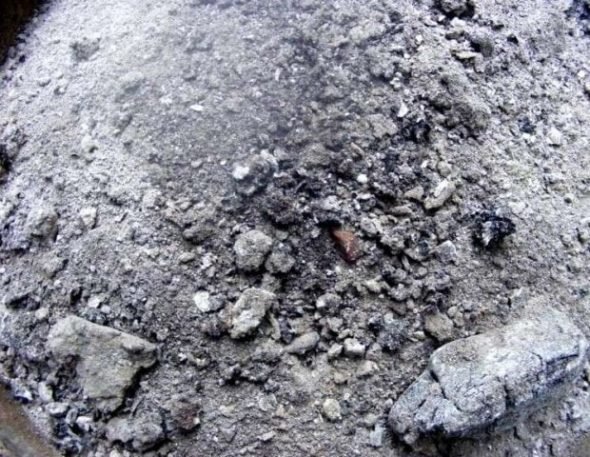

It is an excellent source of potassium and can be used to replace chemical fertilizers. Make a solution: 250 g of ash and 10 liters of water, leave for a day and, in order to feed the radish, water the aisles in the evenings.
When using ash as a top dressing in a greenhouse, avoid adding it together with nitrogen fertilizers: ammonium nitrate, urea and ammonium sulfate will immediately lose their properties. Do not use ash for alkaline soil.
But do not get carried away with fertilizers. The best fertilizer for all plants is regular compost, which any gardener or gardener has.
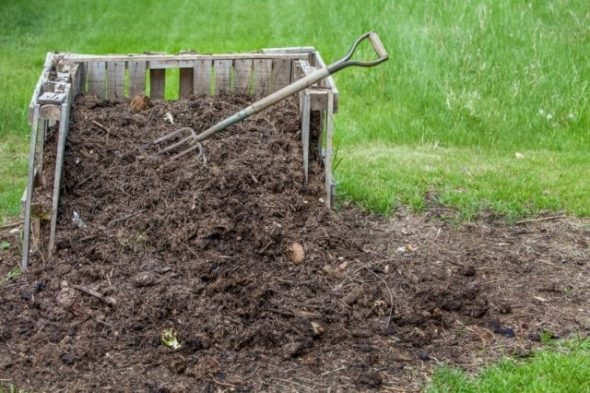

And do not apply nitrogen fertilizers shortly before harvesting, otherwise there will be a high concentration of nitrates in the radish.
Soil mixes
You need to prepare the soil in advance, even in the fall. After harvesting, it is necessary to remove the remnants of plants and dig up the ground, add humus.


There are several options for preparing potting mixes. The following ratios are optimal for radish:
- 40% of field land plus 60% of manure humus;
- 20% low-lying peat plus 40% manure humus plus 40% sod land;
- 60% manure humus plus 40% sod land;
- 50% sod land plus 50% greenhouse and greenhouse land.
Seed preparation
Planting radishes in the open ground in spring
Radish seeds are light brown in color, have a rounded shape. To select the best specimens for planting, they are manually calibrated. When processing a large number of seeds, the planting material is sieved through a coarse mesh sieve. For planting, choose only large, full-weight seeds. When choosing seed material, it is important to pay attention to its shelf life. Old seeds yield poor harvests.
For radish seeds, it is productive to soak them in a natural, nutritious infusion of ash. Such an infusion is prepared from 2 tbsp. l. ash and 1 liter of water, left for two days. The seeds are kept in the ash infusion for 12 hours. The solution saturates the seeds with microelements and accelerates their germination.
To speed up the emergence of seedlings, radish seeds are pre-germinated. To do this, they are kept in a layer of damp cloth in a warm place. After the small sprouts appear, the seeds are ready for sowing in the ground. Germinating seeds gives an idea of their germination.

